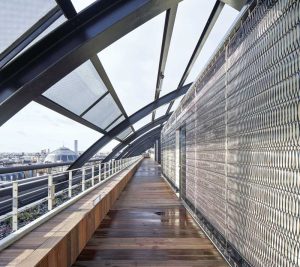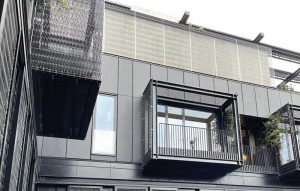
By Dale Payne, PE
With a lack of available space, developing the rooftop, or “fifth facade,” has become an essential solution. Facility managers and specifiers tasked with building and renovating office buildings, schools, and healthcare facilities prioritize health and flexible design while noting How outdoor spaces increase concentration, productivity, healing, and overall occupant wellbeing and satisfaction.
However, designing exterior architectural features can be challenging, as natural elements such as wind, rain, and snow test even the most durable materials. Building products must be weather-resistant and ultraviolet-resistant (UV-resistant), to combat the damaging effects of sunlight; they should also be corrosion-resistant when used in coastal environments and other harsh climates. Materials such as wood will rot and are vulnerable to insect infestation. Polyvinyl chloride (PVC) products will turn yellow in sunlight and become brittle, while porous concrete will stain, crack, and spall. Metal fabric presents a flexible, elegant design option that is also extremely durable—which is an ideal combination for activating a rooftop environment.

Metal fabric on buildings
Woven on a loom just like other textiles, metal fabric is primarily composed of stainless-steel wire, but can be manufactured using other alloys such as bronze, aluminum, and copper. This highly technical material offers architects the ability to create dynamic, modern environments that can address numerous building challenges. It provides a contemporary look and the flexibility for use in large- or small-scale applications for both interior and exterior.
Metal fabric offers a wide range of design options in terms of weave pattern, dimension, color, and texture to create unique facade designs. For example, through metal fabric, a building shell can become an energy-efficient solar protection system that can be adjusted for different times of the day. Bright light-emitting diode (LED) media facades can display high resolution content. Sound-absorbing ceiling systems can improve room acoustics, while semi-transparent room dividers can help structure interior designs.
Depending on the manufacturer, they can provide a complete design-build solution, working with the specifier on concept development, design, engineering, fabrication, delivery, and on-site installation, including proprietary hardware for attachment.




